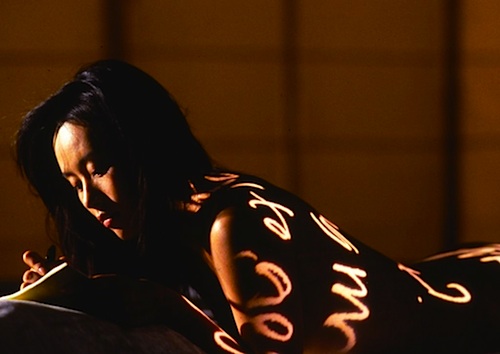By Joe Bendel. Think of it as a Lady Snowblood style payback drama set within the delicate serenity of a rock garden. Born to a Japanese father and a Chinese mother, Nagiko is a fashion model who enjoys the grace of fine literature and calligraphy just as much as the pleasures of the flesh. She also appreciates the satisfaction of revenge served stone-cold. As sensual, transgressive, and erudite as it was when it was initially released nineteen years ago (nearly to the day), Peter Greenaway’s The Pillow Book has now been freshly restored and reissued on DVD and Blu-ray by Film Movement Classics.
As a cherubic young girl, Nagiko always delighted in her father’s birthday face-writing ritual. Since she idolized her novelist father, literature will always play a critical role in her life. However, it is her aunt who first introduces her to the most significant book in her life, Sei Shōnagon’s Pillow Book. Throughout the film, Greenaway incorporates scenes of the Heian-era lady-in-waiting reading her timeless meditations, usually in compartmentalized windows that become part of Greenaway’s wider visual composition.
While Nagiko was still too young to fully understand, she witnesses her father’s publisher sexually exploiting him, as a clear quid pro quo for publishing his work. As she becomes older and more experienced, her father’s humiliation haunts her. Years later, Nagiko will also be published by the same lecher, but he is not the least bit interested in her. To sell the first of her unconventional pillow books, Nagiko paints it on the body of their mutual lover, Jerome, a bisexual British translator. For a while, this method of delivery is quite effective, but love triangles always engender jealousy. In this case, it also leads to tragedy, desecration, and retribution.

Greenaway has always been a distinctive stylist, but Pillow is an especially rich feast for the eyes. He engages in plenty of his characteristic boxing and tiling, but he also channels the look and vibe of Kabuki and Noh theater. It is a gorgeous film, made even more so by Vivian Wu in her breakout, career-defining role. Yet, there is substance underneath Greenaway’s lush surface beauty. Arguably, Pillow Book represents a milestone in experimental storytelling in that it tells a distinct, compelling, and easily followed narrative, within a boldly avant-garde framework.
Quiet but fierce as a lion, Wu commands the screen while steaming it up. A young Ewan McGregor also gives viewers the Full Monty as the immature but passionate Jerome (Obi-Wan, oh behave). Their scenes together explain why the film was never rated. Still, it is important to remember Pillow is not all about sex. In fact, Chizuru Ohnishi and Ken Ogata are quite memorable and engaging as young Nagiko and her father, thereby setting up everything that follows.
With Pillow, Greenaway taps into some deep archetypes, while celebrating Japanese and Chinese culture with the obsessive devotion of a western expatriate. It might just be the greatest Gaijin film ever. Exquisitely crafted, Pillow could still be too scandalous for the timid (arguably, the Lord’s Prayer body painting scene might be needlessly vexing some, since it is not really intended as a provocation), but it is an eerily beautiful film. Highly recommended for fans of challenging auterist cinema, The Pillow Book released this week on DVD and Blu-ray, from Film Movement Classics.
LFM GRADE: A
Posted on June 13th, 2015 at 11:56am.